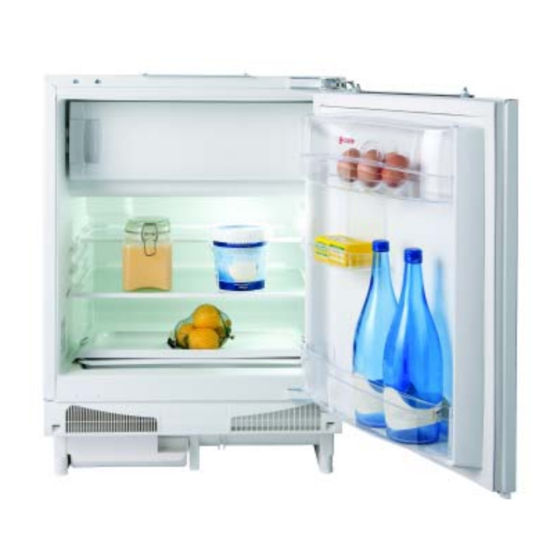
Advertisement
Quick Links
Advertisement

Summary of Contents for Caple RBR3A
-
Page 2: Table Of Contents
Thank you for purchasing this Caple Appliance. This refrigerator is designed for domestic use only and is not intended to be used for commercial storage. The upper part of the freezer should be used for the longer term storage of frozen foods. The compartment is marked with four stars. -
Page 3: Before Using The Appliance
Before using the appliance • Before connecting the appliance, leave it to stand for approximately 2 hours to allow the coolant in the system to settle. • Clean the appliance thoroughly. (See Cleaning and Maintenance). • Ensure that the interior accessories and shelves are in their correct places. -
Page 4: Important
Important • If you have bought this appliance to replace another one, please dispose of the old unit responsibly. • The appliance must be correctly connected to the mains supply. (see: Connecting to the Mains Supply). • If food stored within the refrigerator is discoloured or has an unusual smell, it may have become spoiled and therefore be dangerous to eat. -
Page 5: Positioning And Installation
Positioning and Installation Positioning the Positioning the • Place the appliance in a dry and well ventilated room. Allowed appliance appliance ambient temperature depends on the model (class) of the appliance and is stated on the rating plate of the appliance. Never place the appliance near another appliance that omits heat, such as a cooker or hob. -
Page 6: Description Of The Appliance
Description of the Appliance Refrigerator (A) Refrigerator is used for storing fresh foods for few days. Freezer (B) Freezer is used for freezing fresh foods and for storing already frozen foods. Opening the freezer door Opening the freezer door Shelf (1) The shelf may be placed randomly upon any of the guide slots within the interior of the appliance. - Page 7 Glass shelves are protected with plastic edge frames. Quickly perishable food should be stored on the back i.e. the coldest part of the shelves. Defrost Water Outlet (2) Regularly check the defrost water outlet and the channel, because they should never be clogged (as for example with food rests).
-
Page 8: Operation Control
Operation Control The appliance is controlled with thermostat knob, situated in the right upper part inside the appliance. Turn the knob from STOP (0) position towards 7 and backwards. Temperature Selection Temperature Selection • Higher settings on the knob (towards 7) mean lower temperatures (colder) in all three compartments of the appliance. -
Page 9: Use
By using the appliance correctly and packaging or repackaging of food, the quality of the food stored should be substantially improved. • Food should be properly stored so that smells and fl avours cannot pass between items. • Before storing food in the refrigerator, remove the excessive packaging (like yoghurt in multi-packages). - Page 10 Fresh Food Storage Time in the Refrigerator Article of food Storage time (days) Butter Eggs Meat: fresh uncut chopped smoked Fish Marinade Root Cheese Sweets Fruit Prepared dishes Freezing Fresh Foods Freezing Fresh Foods • Carefully select food you intend to freeze; it should be of adequate quality and suitable for freezing.
- Page 11 • The next time you want to freeze fresh foods, repeat the freezing procedure and be careful that packages with fresh foods do not touch frozen packages. • For freezing smaller amount of foods (up to 1 kg) there is no need to change the thermostat setting (see Temperature Selection).
- Page 12 Defrosting Frozen Food Defrosting Frozen Food Partially thawed or defrosted foods should be used as soon as possible. Cold air preserves the food but it does not destroy microorganisms which rapidly activate after defrosting and make foods perishable. Partial defrosting reduces the nutritional value of foods, especially of fruits, vegetables and ready-made meals.
-
Page 13: Maintenance And Cleaning
Maintenance and Cleaning Automatic Defrosting of Automatic Defrosting of The refrigerator requires no defrosting, since the ice at the rear the Refrigerator the Refrigerator wall melts automatically. Ice, formed at the rear end during the operation of the compressor, melts when the compressor is off, and water drops slide downwards through the hole in the rear wall of the condenser collecting receptacle, placed at the bottom of the appliance. - Page 14 Periodical cleaning of the condenser In order to optimize the operation of the appliance and save energy, it is recommended to clean periodically the dust from the condenser at the back of the appliance. Disconnect the appliance from the mains prior to the commencement of cleaning.
-
Page 15: Trouble-Shooting Guide
Trouble-Shooting Guide During the service, you can come across some problems that in most cases result from improper handling of the appliance and can easily be eliminated. The Appliance Fails to Operate After Connecting to the Mains Supply • Check the supply in the outlet socket and make sure the appliance is switched on (thermostat knob in operating position). - Page 16 Sound alarm The excessive dust upon the condenser is signaled by the sound alarm, heard at each opening of the appliance door – until the default is removed. Check the air circulation through the bottom rail openings and if necessary clean or vacuum the dust from the condenser. See Section Cleaning and Maintenance.
- Page 17 - Check the accesories in the interior of the appliance, they should be placed correctly in their positions; also check the bottles, tins and other vessels that might touch each other and rattle. Bulb Replacement Before replacing the light bulb, disconnect the appliance from the power supply.









Need help?
Do you have a question about the RBR3A and is the answer not in the manual?
Questions and answers